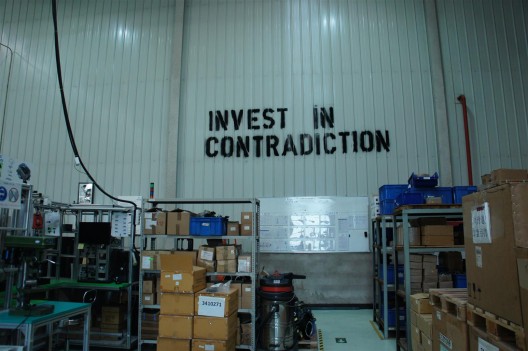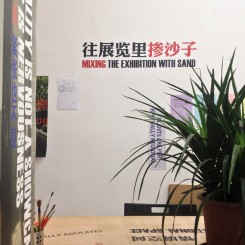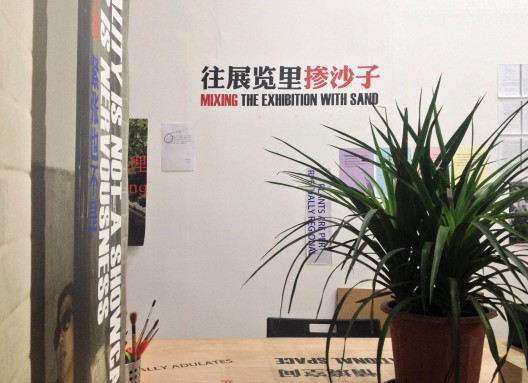This piece is included in Ran Dian’s print magazine, issue 4 (Winter 2016–2017)
Recently, I came across a conversation between Walter Benjamin and Bertolt Brecht (in the former’s book Understanding Brecht, first published in 1966); a bizarre idea occurred to me after reading their discussion of Kafka. If these two people, marked by such immense differences, were to get together in the guise of Chinese men amid the context and circumstances of Mainland China’s art world today, they would undoubtedly launch into an epic feud, hurling abuse at each other. It stands to reason that one was a man of action who strove to turn art into an instrument for social change, while the other was a melancholic literati and polymath who seemed always to occupy a position of ambiguity. They were talking about an “amateur” author living through his own nightmarish ordeals.
But what surprised me was the fact that, although Brecht and Benjamin criticized Kafka, their attitude to him was nonetheless one of respect and affirmation. If we were to adopt a contemporary perspective from which to examine the commonalities between the three, could we safely deduce that Brecht, the most radical among them, is no longer sufficiently radical in today’s eyes? Or is it rather that even Brecht still appreciates the aesthetics of art?
These hypotheses are nothing more than rhetorical questions, for it would be trite to bring up yet again the debate about functionality and aesthetics in art. I am simply curious as to the reasons underlying the divisions and schisms between artists in Mainland China today. These seem to coincide with the divisions between Brecht, Benjamin, and Kafka. Such clear-cut ruptures may not be as easy to explain as they might seem. The widely held view attributes this phenomenon to the intervention of capital following the rise of the art market, since these divisions began to be exacerbated after the Chinese art market “bubble” burst in 2008. In the 1980s, Chinese artists are described as having begun learning about Western contemporary art against the historical backdrop of idealism, experimenting with new mediums and exhibition formats that they had never before been exposed to. Following the explosion of the art market in the 2000s, everybody was busy looking for money. It was only after the bubble burst in 2008 that people started experiencing a sense of anxiety and bewilderment and were forced, finally, to consider what art meant to them in their own context. Another view attributes the schisms to an ever-fragmenting social reality that split artists with different levels of political awareness into opposing camps. In other words, this is simply the normal manifestation of an art world torn between various social forces—according to Bourdieu’s theory (in his 1984 book Distinction: A Social Critique of the Judgement of Taste), even the smallest divergence in taste reflects great ideological chasms. Furthermore, the growing popularity of galleries and art fairs has increa-singly homogenized our judgments of art; this, coupled with (self-)censorship in all manner of artistic activities, in contrast, has intensified the divisions between artists.

在北京伯纳德控制设备有限公司的社会敏感性研发部,项目2,马永峰,《新“大字报”》,(图片由社会敏感性研发部提供)/ Social Sensibility R&D Department at Bernard Controls China, Project no.2, Ma Yongfeng, “Invest in Contradiction”. Courtesy Social Sensibility Research Institute
What has so far not been touched upon relative to this question, however, is a logic inherent in the development of art since Modernism: the fact that it has always revolved around the production of discourse. Works of art do not have to be of any material substance, yet they are invariably expected to be able to engender discourse, or at least dialogue of some sort. The inner logic of the museum, which itself is a social product of art, is not restricted by the museum’s function as a place for viewing, but rather morphs and adapts according to the classification of discourse. The white cube, in the strictest sense, could be without walls or visible artworks, but it is obliged to possess the centralizing force of discourse. In order to produce discourse, art has first to separate itself from obsolete rhetoric. Hence the schisms in Chinese contemporary art stem not only from objective social reality; the same applies to general developments within art. I therefore believe that the reasons causing the schisms among artists stem primarily from the struggle over discourse.
If the production of discourse were indeed a type of inner logic specific to the development of contemporary art, it could also be located in a state of ineffective-ness. The danger of such a centripetal force centered around discursivity stems from the fact that the more marginal it is, the more of what stands out is that which tends towards a discursive center. As a result, once the mechanism of western contemporary art arrived here in China, it had become the oversimplified rules of a game. Though Mainland Chinese artists have absorbed such rules, they are not yet able to use them to fulfill their intended roles. Anybody can adopt something of the essence of Beuys or Warhol, or from it stimulate certain ambitions. But artistic practice in China today has somehow lost its own mode of organization and mobilization, and thus it is unable to formulate an effective context for itself. Consequently, it can only rely on individual cases, or on supplementing sensorial material. This has rendered almost impossible what reformists had hoped for: a self-improving system that relies on the continuous production of discourse.
In the current scenario, the creation of discourse could turn into an assembly line for pernicious or pseudo-discourse. Our situation can be summarized this way: even though nothing new is being created, we are plunging deep into the so-called game of generating words and texts. Artists make heated attempts to locate their identity at the level of discourse, yet they tend to select “opponents” who are the furthest away as well as the least relevant; for example, activists attack painters for producing images, while the proponents of an ontology of art scoff at the vanity and opportunism of “political” art. Articles voicing such vicious critiques in the Chinese art world almost never fail to fall within these categories. In this manner, everybody has safely obtained criticality for themselves while effectively avoiding the cost of actual dialogue. Critique can never definitively succeed or fail, and thus everyone has secured a self-assumed legitimacy.
Under such circumstances, we are confronted with the manufacture of meaningless discourse. Does the solution lie in an alternative method of discursive production, or in avoiding it altogether? If the mechanisms of art have failed in their duty to enact positive reform and rely on basic infrastructures to maintain a superficial prosperity, art can only fall back on galleries and art fairs to leverage popular taste. Hence the increasing number of so-called anti-institutional artists (those who purport to reflect on art institutions). But herein lies the paradox.
In On the New, Boris Groys wrote, “So if an artist says (as the majority of artists say) that he or she wants to break out of the museum, to go into life itself, to be real, to make a truly living art, this can only mean that the artist wants to be collected. This is because the only possibility of being collected is by transcending the museum and entering life in the sense of making something different from that which has already been collected. Again: Only the new can be recognized bythe museum-trained gaze as real, present, and alive.” Can any sort of resistance evade this paradox?
As a matter of fact, some recent art projects indicate the continuation of two different modes of resistance. The first turns art into an apparatus, making specific social reality the goal for action and standard of reference, and in turn reducing art’s internal dis-cursive codes. “The Sixth Ring Road Is One Ring More than the Fifth Ring Road” project (2015)(with Li Yifan, Ge Lei, Ge Fei, Huang Songhao, and Yang Beichen participating) and Liu Weiwei’s project with people in Guangdong Province this year are examples of this. In the first work, in selecting the urban-rural fringe zone between Beijing’s 5th and 6th ring roads as the target of research, the project attempts to bypass already-defunct art scene mechanisms to directly intervene in concrete social issues, turning to mass media to propagate its work and make it take effect. The second mode tries to mitigate the centripetal forces that pull the margin to the center by building up the marginalized as the local and using localized effects to break the homogeneity of the center-margin model. In addition, “The Hinterland Project” (2015) by Shanghai-based artist Shi Qing re-activates artistic production by means of organizing and mobilizing art practices. By rallying artists residing in different Chinese cities to engage their practices with their own local context, the project navigates the local and the marginalized in reverse in order to unleash art’s potential to generate discourse.
Regardless of the method chosen, this model of resistance requires a large amount of concrete field work, as well as a new type of mobilizing mechanism and linkage model, to replace a simple formula of project, exhibition, and documentation. After all, the goal of social practice lies in “using the spade to loosen up the soil,” not to pack in (and solidify) a whole mountain. Often, even after long periods of time, a lot of work is still ineffective. New modes of practice and action have to first establish certain new relations. Fresh frameworks for mobilization are needed to propel our own actions and practices, for we have surpassed the mere consideration of individual artists and works of art.
Does the art world call for more dialogue, or for even more dramatic schisms? Returning to the original hypothesis, if we could imagine the relationship between Kafka, Benjamin, and Brecht as a sort of breadth traversing the spaces internal and external to art, can we say that the growing variety of contemporary art practices today has broadened the distance between the most radical and the most conservative? I think that in this sense, the concepts of the radical and the conservative might have to be redefined.


